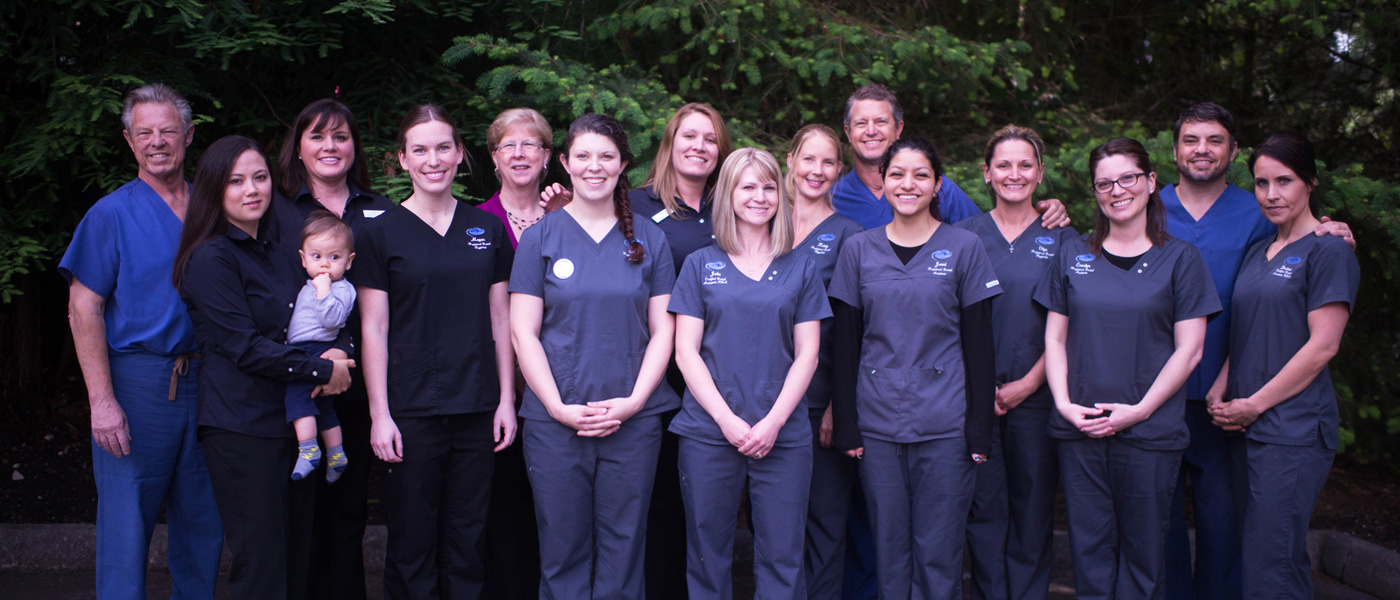
What To Expect During Your First Visit
Our goal is to make your root canal treatment the best possible dental procedure ever. We understand there are few people who embrace tooth pain and actually enjoy dental procedures. That’s why we take exceptional care to make the process as comfortable, simple, and transparent as possible so you know what to expect. When we’re all on the same page, we’re able to most effectively do our job, which is to save your tooth and get you back to feeling normal as quickly as possible.
Here’s what we need to know when you connect with our front desk team :
- Have you been a patient in our office before?
- What is the name of your referring dentist?
- We need your name, birthdate, address and contact information
- What tooth or area of your mouth do we need to evaluate?
- Are you having any discomfort with your tooth?
- Is there a day or time of the week that works best for your schedule?
After scheduling your appointment, we will send new patient paperwork to your home. You will bring the completed new patient information to your appointment along with a referral slip from your dentist. Included with the paperwork is a map with directions to our office, or you can find our office location here. Our office will contact you two days prior to confirm your appointment and address any last-minute questions you may have.
Treatment Sequence
First Visit
Establish your need for special endodontic treatment through a medical history and pulpal examination. Pulpal exam means root canal treatment assessment. If you need a root canal, we can help. If you don’t, we’ll let you know that and suggest an alternative treatment plan.
Take endodontic records such as safe digital radiographs and, if appropriate, begin treatment immediately
Educate you about the cause of your endodontic condition, the treatment sequence, and the projected course of healing
Payment Arrangements
The fees for your endodontic treatment will be based on the extent of treatment
During your first visit we will determine the probable number of visits, duration of visits, and your investment fee. Our policy is that your care be paid for during the course of treatment
Treatment
Save your tooth and prepare a firm support for your dentist’s restoration
Follow-Up
Connect you with your family dentist for a protective crown, bridge or other dental device
Examine your tooth periodically to check healing
Frequently Asked Questions
Can my tooth be saved?
Endodontic treatment has over a 95% success rate
How long can I expect my tooth to last?
When treated successfully, it should last for your lifetime
What will be my experience?
Our patients report, “a positive, comfortable, and compassionate experience”
How many visits will be necessary?
Usually one (1) appointment following the initial visit, which is devoted to diagnosis and consultation. Diagnosis and treatment will be combined whenever possible.
Why should I save my tooth?
Unnecessary extraction of a tooth is financially and biologically costly. From a financial perspective, an extraction, replacement bridge, or implant may often cost more than endodontic treatment and restoration. In terms of biology, extraction alone, without replacement can have many unhealthy biological side effects and consequences that can include compromised speech, loss of support structure for neighboring teeth, and premature aging of your facial appearance. A tooth replacement can injure adjacent anchor teeth, is weaker, and is more difficult than natural teeth to keep clean. In short, there is no substitute for your own tooth. Your tooth is the real thing and we will do everything in our power to help save it!
Who are your endodontists?
Our team of endodontists, are listed on our team page. Our doctors are AAE Certified and take great care to ensure you have the best treatment possible.
Is a root canal painful?
Many endodontic procedures are performed to relieve the pain of toothaches caused by pulp inflammation or infection. Our endodontists understand a great deal about pain management. With modern techniques and anesthetics, the vast majority of patients report that they are comfortable during the procedure. For the first few days after treatment, your tooth may feel sensitive, especially if there was pain or infection before the procedure. Over-the-counter medications, such as Advil® or Tylenol®, are usually enough to manage this sensitivity. In some cases, prescription medications may be necessary and are available from your endodontist. Follow your endodontist’s instructions carefully.
Your tooth may continue to feel slightly different from your other teeth for some time after your endodontic treatment is completed. Of course, if you experience pressure or pain that lasts more than a few days, contact us.
What is endodontic treatment?
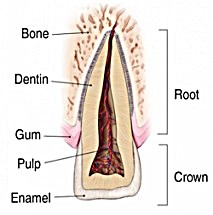 Endodontic treatment involves the inside of the tooth. “Endo” is the Greek word for “inside” and “odont” is Greek for “tooth.”
Endodontic treatment involves the inside of the tooth. “Endo” is the Greek word for “inside” and “odont” is Greek for “tooth.”
To understand endodontic treatment, it helps to know something about the anatomy of the tooth. Inside the tooth, under the white enamel and a hard layer called the dentin, is a soft tissue called the pulp. The pulp contains blood vessels, nerves, and connective tissue, and creates the surrounding hard tissues of the tooth during development.
The pulp extends from the crown of the tooth to the tip of the roots where it connects to the tissues surrounding the root. The pulp is important during a tooth’s growth and development. However, once a tooth is fully mature, it can survive without the pulp, because the tooth continues to be nourished by the tissues surrounding it.
How does endodontic treatment save the tooth?
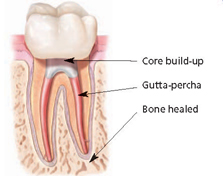
During root canal treatment, the inflamed or infected pulp is removed and the inside of the tooth is carefully cleaned and disinfected. It is then filled and sealed with a rubber-like material called gutta-percha. Afterwards, the tooth is restored with a crown or filling for protection. After restoration, the tooth continues to function like any other tooth.
Modern root canal treatment is very similar to having a routine filling and usually can be completed in one or two appointments, depending on the condition of your tooth and your personal circumstances. You can expect a comfortable experience during and after your appointment.
Saving the natural tooth with root canal treatment has many advantages:
- Efficient chewing
- Normal biting force and sensation
- Natural appearance
- Protects other teeth from excessive wear or strain
Endodontic treatment helps you maintain your natural smile, continue eating the foods you love and limits the need for ongoing dental work. With proper care, most teeth that have had root canal treatment can last as long as other natural teeth and often for a lifetime.
What is Endodontic Surgery?
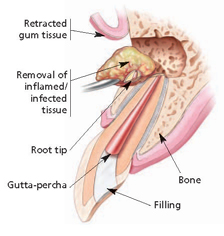 Occasionally, a nonsurgical root canal procedure alone cannot save your tooth and your endodontist will recommend surgery. Endodontic surgery can be used to locate small fractures or hidden canals that weren't detected on x-rays or during previous treatment. Surgery may also be needed to remove calcium deposits in root canals, to treat damaged root surfaces, or the surrounding bone of the tooth. To learn more about endodontic surgery, talk to an endodontist in your area.
Occasionally, a nonsurgical root canal procedure alone cannot save your tooth and your endodontist will recommend surgery. Endodontic surgery can be used to locate small fractures or hidden canals that weren't detected on x-rays or during previous treatment. Surgery may also be needed to remove calcium deposits in root canals, to treat damaged root surfaces, or the surrounding bone of the tooth. To learn more about endodontic surgery, talk to an endodontist in your area.
There are many surgical procedures that can be performed to save a tooth. The most common is called an apicoectomy, or root-end resection, which is occasionally needed when inflammation or infection persists in the bony area around the end of your tooth after a root canal procedure. In this microsurgical procedure, the endodontist opens the gum tissue near the tooth to see the underlying bone and to remove any inflamed or infected tissue. The very end of the root is also removed. A small filling may be placed to seal the end of the root canal and a few stitches or sutures are placed to help the tissue heal. Over a period of months, the bone heals around the end of the root. Local anesthetics make the procedure comfortable, and most patients return to their normal activities the next day. Postsurgical discomfort is generally mild.
Learn more about endodontic surgery, including a step-by-step explanation of the most common surgical procedure, apicoectomy.
Who performs endodontic treatment?
All dentists, including your general dentist, received training in endodontic treatment in dental school. General dentists can perform endodontic procedures along with other dental procedures, but often they refer patients needing endodontic treatment to endodontists.
Endodontists are dentists with special training in endodontic procedures. They provide only endodontic services in their practices because they are specialists. To become specialists, they complete dental school and an additional two or more years of advanced training in endodontics. They perform routine as well as difficult and very complex endodontic procedures, including endodontic surgery. Endodontists are also experienced at finding the cause of oral and facial pain that has been difficult to diagnose.
How will my injury be treated?
Chipped or Fractured Teeth
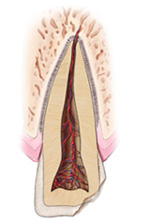 Most chipped or fractured tooth crowns can be repaired either by reattaching the broken piece or by placing a tooth-colored filling. If a significant portion of the tooth crown is broken off, an artificial crown or “cap” may be needed to restore the tooth.
Most chipped or fractured tooth crowns can be repaired either by reattaching the broken piece or by placing a tooth-colored filling. If a significant portion of the tooth crown is broken off, an artificial crown or “cap” may be needed to restore the tooth.
If the pulp is exposed or damaged after a crown fracture, root canal treatment may be needed. These injuries require special attention. If breathing through your mouth or drinking cold fluids is painful, bite on clean, moist gauze or cloth to help relieve symptoms until reaching your dentist’s office. Never use topical oral pain medications (such as Anbesol®) or ointments, or place aspirin on the affected areas to eliminate pain symptoms.
Injuries in the back teeth often include fractured cusps, cracked teeth and the more serious split tooth. If cracks extend into the root, root canal treatment and a full coverage crown may be needed to restore function to the tooth. Split teeth may require extraction.
Dislodged (Luxated) Teeth
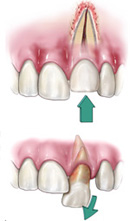 During an injury, a tooth may be pushed sideways, out of or into its socket. Your endodontist or general dentist will reposition and stabilize your tooth. Root canal treatment is usually needed for permanent teeth that have been dislodged and should be started a few days following the injury. Medications, such as calcium hydroxide, may be put inside the tooth as part of the root canal treatment. A permanent root canal filling will be placed at a later date.
During an injury, a tooth may be pushed sideways, out of or into its socket. Your endodontist or general dentist will reposition and stabilize your tooth. Root canal treatment is usually needed for permanent teeth that have been dislodged and should be started a few days following the injury. Medications, such as calcium hydroxide, may be put inside the tooth as part of the root canal treatment. A permanent root canal filling will be placed at a later date.
Children between seven and 12 years old may not need root canal treatment since their teeth are still developing. For those patients, an endodontist or dentist will monitor the healing carefully and intervene immediately if any unfavorable changes appear. For this reason, multiple follow-up appointments are likely to be needed. New research indicates that stem cells present in the pulps of young people can be stimulated to complete root growth and heal the pulp following injuries or infection.
Knocked-Out (Avulsed) Teeth
 If a tooth is completely knocked out of your mouth, time is of the essence. See an endodontist or dentist immediately! Handle the knocked-out tooth very gently, avoid touching the root surface, and follow these steps to protect the tooth.
If a tooth is completely knocked out of your mouth, time is of the essence. See an endodontist or dentist immediately! Handle the knocked-out tooth very gently, avoid touching the root surface, and follow these steps to protect the tooth.

Your endodontist or dentist will carefully evaluate the tooth, place it back in its socket and examine you for any other dental and facial injuries. A stabilizing splint will be placed for a few weeks. Depending on the stage of root development, your dentist or endodontist may start root canal treatment a week or two later. A medication may be placed inside the tooth followed by a permanent root canal filling at a later date.
The length of time the tooth was out of the mouth and the way the tooth was stored before reaching the dentist influence the chances of saving the tooth. Again, immediate treatment is essential. Taking all these factors into account, your dentist or endodontist may discuss other treatment options with you.
Root Fractures
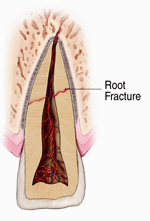 A traumatic injury to the tooth may also result in a horizontal root fracture. The location of the fracture determines the long-term health of the tooth. If the fracture is close to the root tip, the chances for success are much better. However, the closer the fracture is to the gum line, the poorer the long-term success rate. Sometimes, stabilization with a splint is required for a period of time.
A traumatic injury to the tooth may also result in a horizontal root fracture. The location of the fracture determines the long-term health of the tooth. If the fracture is close to the root tip, the chances for success are much better. However, the closer the fracture is to the gum line, the poorer the long-term success rate. Sometimes, stabilization with a splint is required for a period of time.
Do traumatic dental injuries differ in children?
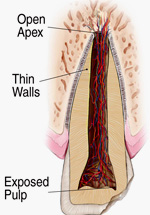 Chipped primary (baby) teeth can be esthetically restored. Dislodged primary teeth can, in rare cases, be repositioned. However, primary teeth that have been knocked out typically should not be replanted. This is because the replantation of a knocked-out primary tooth may cause further and permanent damage to the underlying permanent tooth that is growing inside the bone.
Chipped primary (baby) teeth can be esthetically restored. Dislodged primary teeth can, in rare cases, be repositioned. However, primary teeth that have been knocked out typically should not be replanted. This is because the replantation of a knocked-out primary tooth may cause further and permanent damage to the underlying permanent tooth that is growing inside the bone.
Children’s permanent teeth that are not fully developed at the time of the injury need special attention and careful follow up, but not all of them will need root canal treatment. In an immature permanent tooth, the blood supply to the tooth and the presence of stem cells in the region may enable your dentist or endodontist to stimulate continued root growth.
Endodontists have the knowledge and skill to treat incompletely formed roots in children so that, in some instances, the roots can continue to develop. Endodontists will do all that is possible to save the natural tooth. These specialists are the logical source of information and expertise for children who are victims of dental trauma.
